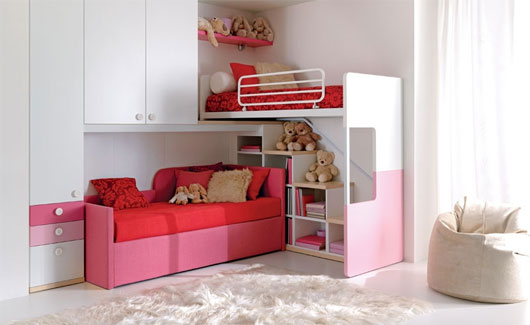The average youngster sleeps 40% of the time, a crucial aspect of their growth – making your child’s bedroom an instrumental aspect of their development. Its décor and arrangement, then, is not to be underestimated! Decorating your child’s bedroom is hard enough by itself, but unless you want to be forking out the same money year on year, futureproofing needs to be high on the decorating agenda. Here are a few handy tips on how to approach making your child’s room a haven for play and sleep, and also free from the threat of being outgrown.
Walls
The colour palette for the room will set the mood of the room, so careful choice of a colour scheme that not only promotes rest but eschews dating is necessary. With this in mind, patterned wallpapers might be pushed to one side in favour of matte, block painted walls. Soft colours are sure to aid sleep – pastel blues and creams keep the room neutral, calm and bright. Primary colours are a no-no in this respect, since they can be a little too loud and distracting, especially if your child also works in their room. The room’s neutrality also enables them to ornament their room however they like without ri of colour clashes, preserving their need to create and make their room personal to them.
Furniture
The correct choice in sleeping apparatus is key for your child and the feel of their room. In the interests of future-proofing, a larger single bed eliminates the cost of future furniture as your kid grows into teenagehood – a single Ottoman would be perfect for purpose, being big enough to house a fully-grown sprog and simultaneously providing prodigious storage space to boot! With this, extra cabinets and cupboards might be rendered unnecessary, reducing the risk of clutter and increasing the available free space for your child to play in.
Wardrobes and cabinets that are necessary, however, should be sourced with the décor firmly in mind. Storage made with pastel-coloured or light-wood materials fit in keeping with your wall colours, and accommodate your child’s individual ornament choices well, making a great adaptable base style for the room.
Accessories
Choosing adornments and accessories for your child’s room can be a great opportunity to let your child in on the decorating process, and so a great chance for some quality time! Rugs and throws are great for pulling a room together. Make choosing a rug a joint endeavour, allowing your child to inflect the general scheme of the room with some of their personality. The rug is the cheapest and most easily interchangeable part of the room, and so well worth marking out as impermanent as far as your child is concerned. A change in rug every few years can keep the room fresh, and keep your youngster from demanding any drastic changes. Curtains are similarly interchangeable, but be sure to invest in blackout curtain-backs so as to guarantee your child’s restful sleep, and reduce the chance for that dreaded plea at 2 in the morning: ‘Muuuummmm?’
And there we have it! My key considerations for your child’s futureproof bedroom. Were these tips helpful to you? Do you have any useful decorating thoughts to go with these? Respond below with your suggestions for a pain-free, sleep-ready youngster’s bedspace!
Written by Olivia Prat



























Great tips. I keep my kids’ rooms fairly neutral in paint and carpets and so on, so I can then update with accessories, duvet sets and freshen up as and when.